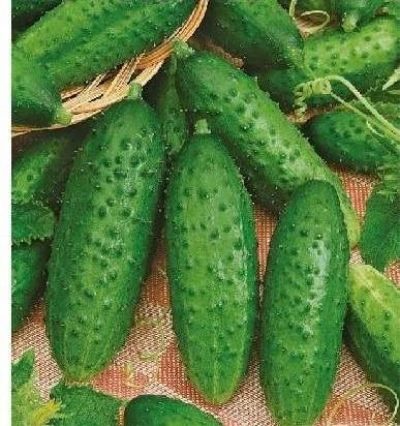
- Authors: HORAL JIRI, Alekseev Yu.B.
- Year of approval: 1998
- Growth type: vigorous, indeterminate
- Branching: the average
- Fruit weight, g: 68-94
- Fruit length, cm: 8-10
- Fruit color: green
- Cucumber Mosaic Virus Resistance: stable
- Ripening terms: early
- Pollination: bee-pollinated
Cucumber Moravian gherkin is a middle-aged culture, due to which it has already won the love of gardeners. It is appreciated for its resistance to bad weather, excellent taste of the fruit. In addition, choosing this variety, you can count on a bountiful harvest.
Breeding history
The breeder Alekseev Yu.B. worked on the breeding of the described variety in 1998, the variety was admitted to mass cultivation and joined the ranks of the State Register of the Russian Federation.
Description of the variety
This cucumber variety belongs to the list of hybrids. It is recommended to cultivate it both outdoors and under the cover of greenhouses.
Characteristics of the appearance of plants and zelents
According to the type of growth, experts have included the Moravian gherkin in the list of vigorous and indeterminate. Vines of medium length branch moderately. Pale green small leaves are slightly wrinkled and have wavy edges.
Fruits are also green in color, repeat the shape of a spindle and have a modest length of 8-10 centimeters. One cucumber weighs 68-94 grams. On the peel of the vegetable, tubercles and thorns with whitish pubescence are noticeable.
Purpose and taste of fruits
The Moravian gherkin is universal, it can not only be eaten, but also pickled, salted for the winter in containers of any size. The fruits exude a persistent aroma, do not have bitterness, their flesh crunches pleasantly, is noticeably juicy and tasty.
Maturation
The culture blooms mainly with female flowers. In terms of ripening, the vegetable manifests itself as an early type. Bees act as pollinators of the plant. The fruiting phase starts 40-45 days after planting cucumbers.
Yield
The Moravian gherkin delights summer residents with generous productivity. With proper care per hectare, gardeners extract an average of 167-392 centners of vegetables.
Growing regions
The cultivation of the described variety is especially widespread in the Middle Volga (Samara, Penza, Ulyanovsk regions) and in the Lower Volga region (Volgograd, Saratov, Astrakhan regions).
Landing scheme
In the process of planting, it is necessary to leave a distance of about 70 centimeters between the rows, in addition, the distance between the bushes must be observed (about 30 centimeters).
Growing and care
The sowing of hybrid seeds is started at the end of April. The day before, you should fertilize the soil with leaves and sawdust. The seeds are immersed in the ground by about one and a half to two centimeters. The optimum temperature that must be provided for the process is 25 degrees. When the shoots are formed, the heating of the room can be reduced to 15 degrees. It is recommended to move young plants into open ground or a greenhouse in a warm season - in late May or early June.
During the growing season of cucumbers, fertilizing is introduced into the soil once every 10-15 days. It can be a mixture of urea or manure with water, potassium, superphosphate, nitrogen.
From time to time it is worth freeing the beds from weeds, carrying out loosening and hilling procedures. Watering is desirable in the evenings, with warm water, once every couple of days.
Due to its high growth, the Moravian gherkin requires a garter, this measure will protect against breaking the stem. Ripe vegetables are harvested in the morning, if possible every day.
Soil requirements
It has been noticed that the Moravian gherkin feels good if the land is fertile and rich in oxygen. For example, these types include solonetz, gray forest, light chestnut, light gray forest soils.

In order to collect strong, tasty and beautiful cucumbers on your site, you need to make top dressing. Lack of nutrients can negatively affect the appearance of the plant and significantly reduce the yield. Fertilize cucumbers with organic fertilizers in combination with mineral fertilizers. With the right balance of these components and adherence to the fertilizing schedule, the cucumber yield will be maximum.
Required climatic conditions
When deciding on a planting site for a vegetable in a summer cottage, it is worth making a choice in favor of a site that generously receives sunlight or is in partial shade, sheltered from drafts.
Disease and pest resistance
The plant shows significant resistance to such ailments as powdery mildew, cucumber mosaic, brown olive spot. The hybrid is slightly less resistant to downy mildew.

Despite their popularity, cucumbers are often attacked by diseases and pests. From them, cucumber plantings often die before the start of fruiting. In order to prevent this from happening, it is necessary to try to prevent ailments or get rid of them at the very beginning, having studied in detail their causes of occurrence, signs and methods of treatment.
Review overview
Not only experienced gardeners, but also beginners give the above variety a high rating. They note that the culture royally gives the owner a harvest even in hot or cold summers. According to reviews, the greens are smooth, elastic, do not outgrow and taste good. In addition, they contain many vitamins, and their small size is convenient for canning.





























































































